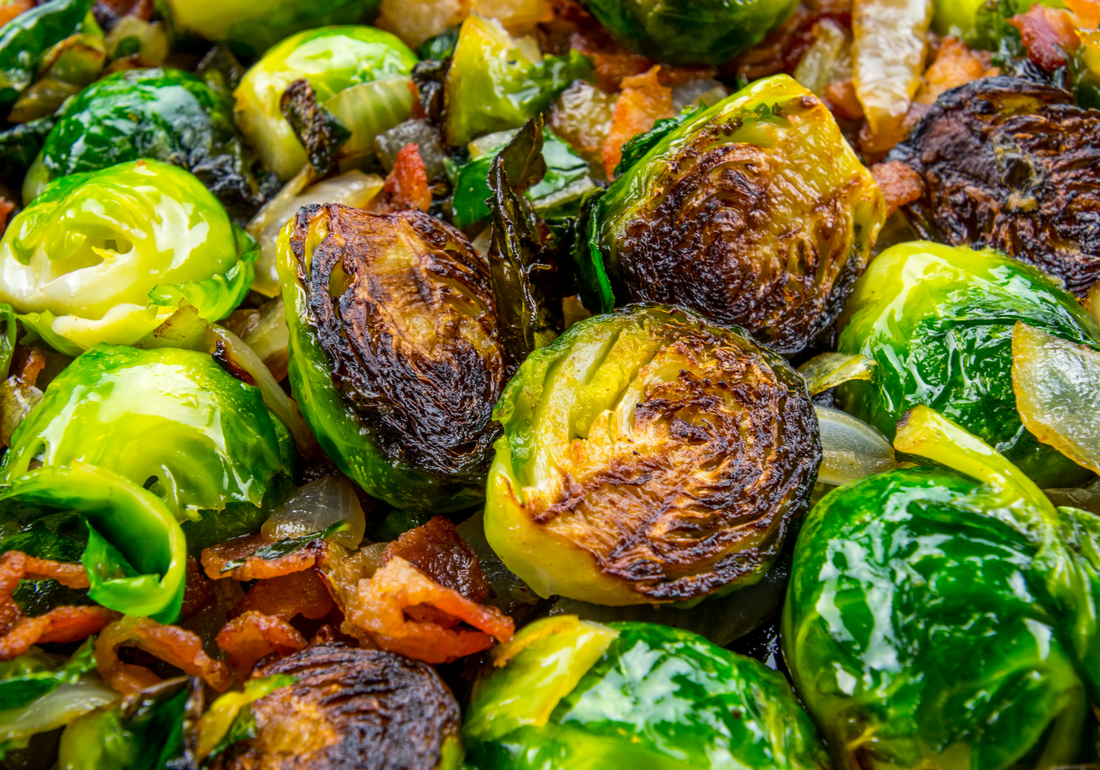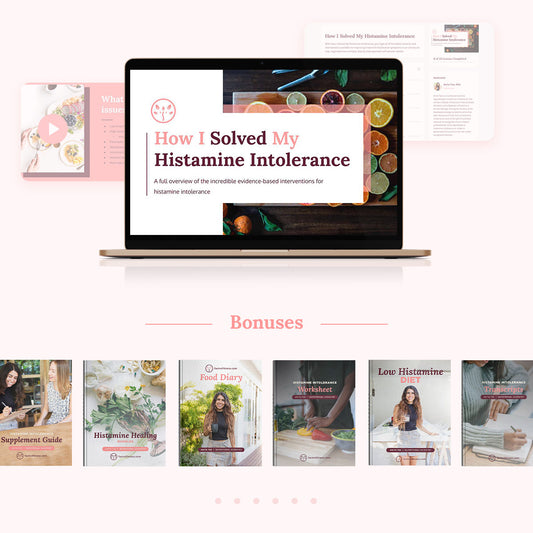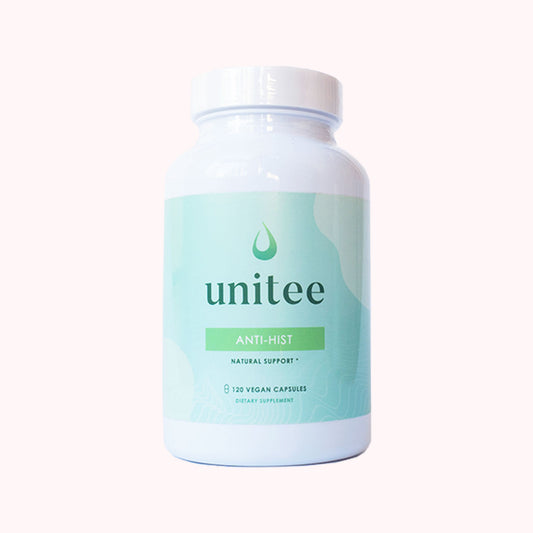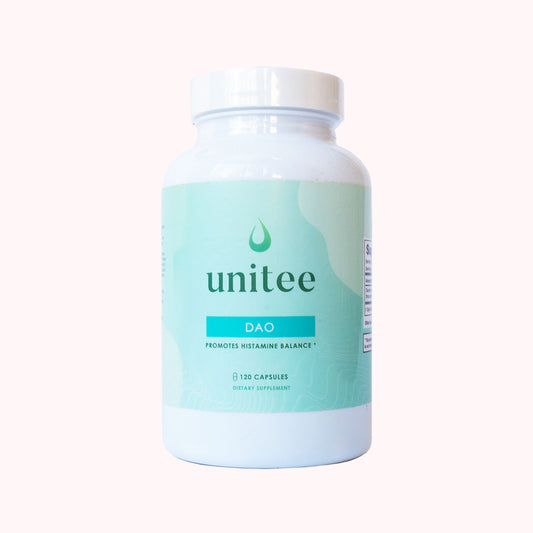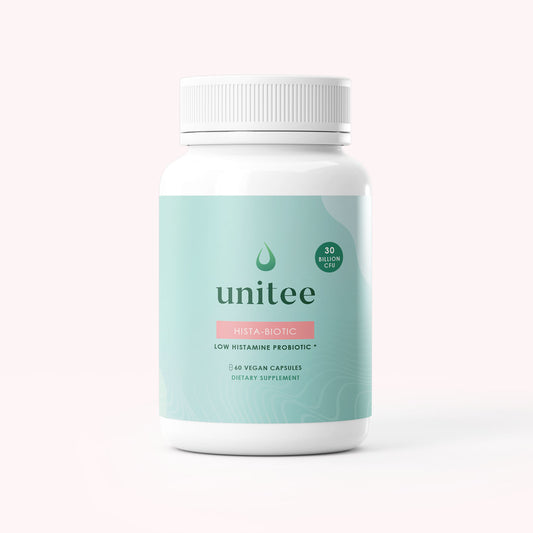Ready for a warm twist on the typical raw low histamine salad?
Well, you're in luck because it's salad time!
Nothing beats a salad when it comes to a super easy way to pack in your veggies and nutrients. But, let's face it... salad can be pretty bo-ring! And another thing… Salad can be super triggering when it comes to all of those histamine aggravating ingredients. Tomatoes, we’re looking at you!
So, today, I've got a roasted twist on your typical low histamine salad recipe.
Getting creative with salads can be hard when you're histamine intolerant. No tomatoes, no spinach, and none of the best roasted veggies (because let's get real, roasted eggplant = yum).
But, I've got a low histamine recipe that will tickle your taste buds and give your body all of the right nutrients.
Let's look at each of the suggested low histamine ingredients a little more closely...
Low Histamine Salad Recipe: Ingredients Breakdown
We all know by now that I like evidence. Every ingredient in my recipes are carefully chosen based on what's best for histamine intolerance - and, I like to give you the breakdown.
So, let me give you a bit of evidence behind why I believe this is the best low histamine salad:
Cauliflower: Cauliflower is a nutrient powerhouse. It’s very low calorie, but really packs a big punch when it comes to the range of minerals and vitamins it contains. For example, a 1 cup serving of cauliflower provides 12% of your daily recommended intake of vitamin B6, which you know is an essential nutrient that’s needed for the formation of the histamine-degrading enzyme DAO.
It’s also a sulfur-containing vegetable, which is an important factor when it comes to histamine intolerance. Often, detoxification pathways are a little sluggish and, with the addition of a little sulfur, may help the body to clear up some of those toxins.
Another interesting compound found in cauliflower is called choline. Many people don’t have enough choline in their diets, which has been linked to the development of fatty liver disease. Choline also plays a role in methylation, which is an important process in the body used to control how the body’s genetic information is processed. The Cleveland Clinic suggests that around 50% of people need more of these nutrients like choline, to support their increased demands for methylation to take place efficiently (1).
Cauliflower contains compounds which have shown to regulate immune health and gene expression - and even act against cancer! This vegetable is truly one of the top players when it comes to benefiting the gut and total-body health (2).
Fresh veggies: Fresh vegetables are highly recommended when looking for low-histamine foods - this ensures no fermentation has taken place and histamine levels are at their lowest compared to vegetables that have been sitting for a period of time (3). Putting a spin on a regular salad, by using vegetables and pan-roasting them until tender, can be a huge crowd-pleaser. Additionally, roasted veggies are easier to digest for those who have trouble eating mountains of raw veggies.
Consider adding a variety of the following to your salad; mix and match as you see fit: broccoli, cauliflower, asparagus, artichoke, zucchini, parsnips, corn, carrots, Brussel sprouts, beets, and radish. They’re all great roasted with a touch of coconut oil or grass fed butter, and a sprinkle of Himalayan salt.
Personal tolerance: All vegetables in this recipe are acceptable and promoted for a low-histamine diet, however, cauliflower and bell peppers have been shown to be digestive distress culprits, and might not be tolerated well by those with autoimmune conditions, IBS or leaky gut (4,5). Cooking these veggies will make them easier to digest - but, if you're particularly sensitive, you may want to add in smaller amounts or cook them until extra tender.
Fun with fats: Coconut oil and grass-fed butter are excellent choices for cooking oil/fats, as they have a high smoke point, as well as huge on flavour! These fats also promote the release of bile, a powerful digestive fluid, to improve digestive processes and nutrient absorption (6).
Fun histamine fact: while many people don’t tolerate dairy very well and so avoid butter, I find that most people do well with adding a small amount of grass-fed butter to their meals. Grass fed butter has lower total casein and lactose, which are the protein and sugars in dairy that most people react to. Grass fed butter is also more nutritious than regular butter, containing more anti-inflammatory omega 3 fatty acids and conjugated linoleic acid (CLA); so always aim to go for the best quality here to get the maximum benefit to your health (7,8).
Added benefits: If you want to achieve even more nutritional benefits from this histamine intolerance recipe, try out my low histamine salad dressing recipe to top off this low histamine salad recipe.
Want to mix it up with the veggies? Feel free to substitute or add any of the low histamine veggies from my low histamine diet. Click below to get the full list of low histamine veggies!
Roasted Low Histamine Salad Recipe
Ingredients:
- 1 cup cauliflower florets
- 1 cup broccoli florets
- 1 cup brussels sprouts, trimmed and cut in half
- 1 cup red bell pepper, cut into 1-inch pieces
- 1 cup squash
- 2 tbsp Coconut oil/grass-fed butter
Directions:
- Preheat oven to 400F.
- Prepare a large, parchment-lined baking sheet.
- Add all cut up veggies to a bowl and gently mix with coconut oil or grass-fed butter until well combined.
- Place all veggies onto the baking sheet and spread out evenly.
- Bake for 40 minutes or until tender, stirring every 10 minutes for even browning.
- Remove the veggies from the oven, allow to cool slightly and place them into a bowl.
- Salt to taste or toss with homemade herby low histamine salad dressing and serve warm, topped with fresh herbs and/or sprouts.
Want more low histamine recipes like this? Check out my nutritionist-approved Low Histamine Cookbook with 110 delicious histamine intolerance recipes!
References
- Mehedint MG, Zeisel SH. Choline's role in maintaining liver function: new evidence for epigenetic mechanisms. Curr Opin Clin Nutr Metab Care. 2013;16(3):339-345. doi:10.1097/MCO.0b013e3283600d46
- Balch PA. Prescription for Nutritional Healing. 4th ed. Avery, editor. London: Penguin Group; 2006. 980 p.
- Ede G. Histamine Intolerance: why freshness matters. J Evol Heal. 2017;2(1):11.
- Hoffman BD. What is Mast Cell Activation Syndrome? Hoffman Centre for Integrative and Functional Medicine. 2017.
- Maintz L, Novak N. Histamine and histamine intolerance. Am J Clin Nutr. 2007;85(5):1185–96.
- Perreard M, Iconomidis N, Bernard C, Chayvialle J, Gerolami A. Effect of a low-fat diet on the fasting volume and postprandial emptying of the gallbladder. Gastroenterol Clin Biol. 1993;17(6-7):435-40.
- Hebeisen DF, Hoeflin F, Reusch HP, Junker E, Lauterburg BH. Increased concentrations of omega-3 fatty acids in milk and platelet rich plasma of grass-fed cows. Int J Vitam Nutr Res. 1993;63(3):229-233.
- Stockinger, B., Meglio, P., Gialitakis, M. and Duarte, J. (2014). The Aryl Hydrocarbon Receptor: Multitasking in the Immune System. Annual Review of Immunology, 32(1), pp.403-432.

Anita Tee
My name is Anita Tee. I'm a nutritional scientist who specializes in histamine intolerance. I hold a Master of Science in Personalized Nutrition and a Bachelor of Science in Human Biology and Psychology. For the past ten years, I have used my experience in nutritional and medical health sciences to create a scientifically backed, natural approach to healthcare that relies 100% on evidence-based research. As I previously suffered from - and overcame - histamine intolerance, my focus is to increase recognition and expand the available resources and protocols available for resolving this particular disorder. To date, I have helped over 4,000 individuals fully resolve or better manage their histamine intolerance symptoms.

